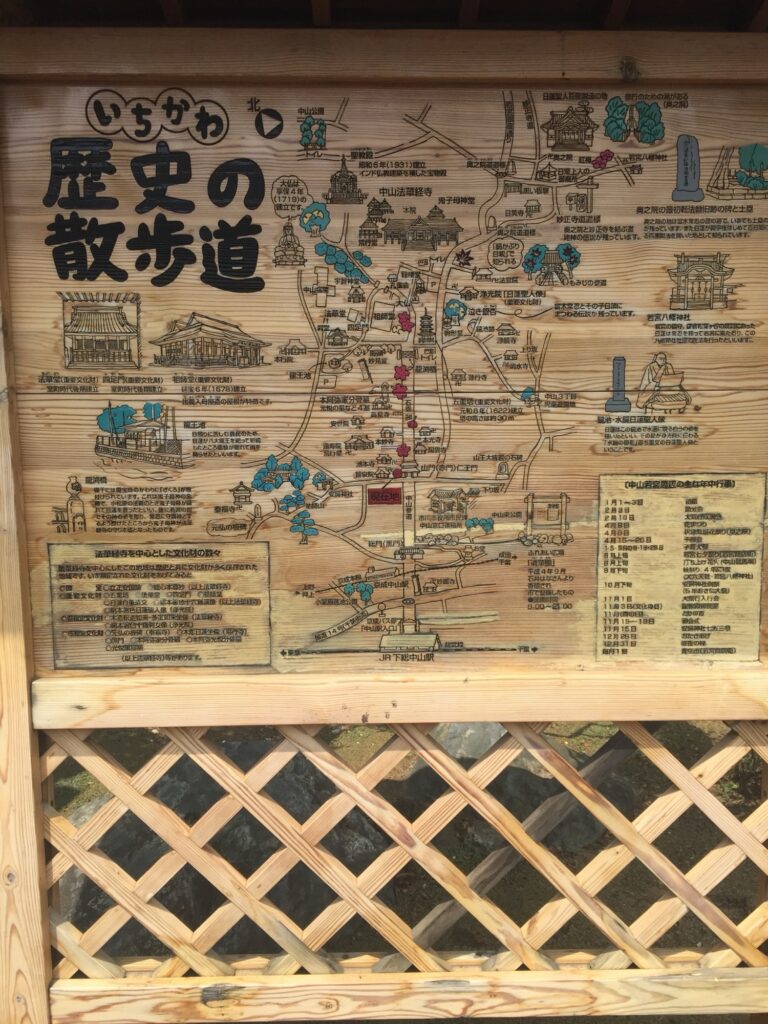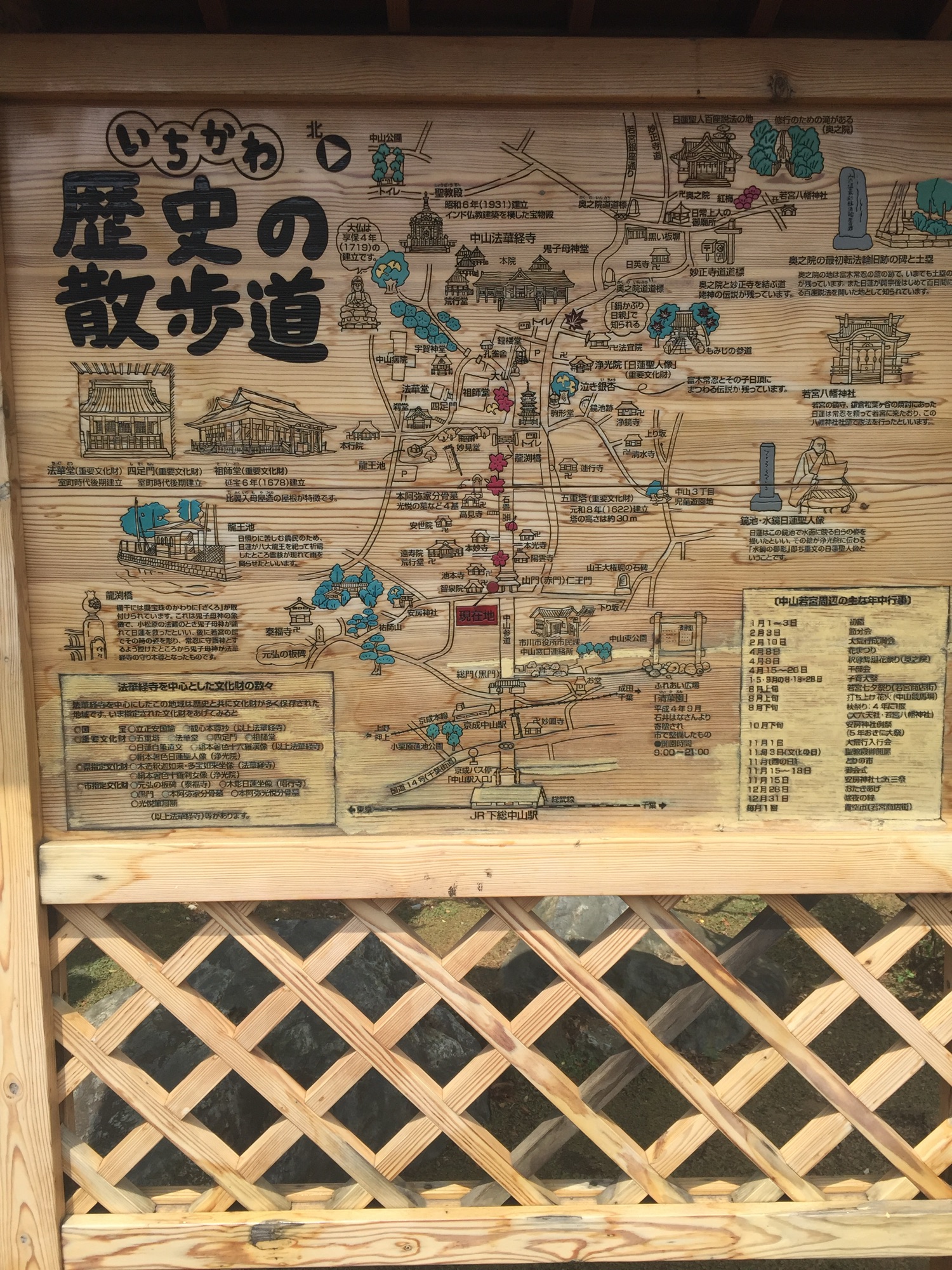Ain’t this signboard just the coolest thing? You can really feel the deep history behind it, don’t ya think?
Lemme give y’all a quick little rundown of what’s written on it!
Title & Orientation
“Ichikawa Historical Walking Route” – the arrow shows that the top of the map is north.

Central Zone – Nakayama Hokekyō-ji Temple
- Great Buddha Hall (1719).
- Scripture Hall (1931), a reinforced-concrete building in an Indian-style design.
- Hokkedō Hall and Shishikadomon Gate – late-Muromachi-period Important Cultural Properties.
- Soshi-dō Hall (1678) – Important Cultural Property with a distinctive double-hipped roof.
- Five-storied Pagoda (1622, ~30 m) – Important Cultural Property.
- Kishimojin Hall – guardian-deity hall featuring pomegranate carvings symbolic of child protection.
- Dragon-King Pond – Nichiren prayed here for rain on behalf of local farmers, and rainfall followed.
- Ryūtō-banbashi Bridge – its balustrade is decorated with pomegranates; the bridge has come to serve as a talisman of the temple.
Oku-no-in (Inner Sanctuary) Area
- Spot where Saint Nichiren delivered sermons for one hundred days.
- A waterfall for ascetic training.
- An earthen mound and stele marking the “first turning of the Dharma-wheel”.
- A stone way-marker pointing to Myōshō-ji Temple; local legend still recounts the route.
Nearby Shrines & Statues
- Wakamiya Hachiman Shrine (local tutelary shrine).
- Uga-jinja Shrine and smaller chapels on Sakakibara-yama hill.
- Mirror Pond & the “Water-Mirror” Statue of Nichiren – said to depict the moment he pledged to spread the faith while gazing at his reflection.
Registered Cultural Assets
- National Treasures: the treatises Risshō Ankoku-ron and Kanjin Honzon-shō (kept at Hokekyō-ji).
- Important Cultural Properties: the Five-storied Pagoda, Hokkedō, Shishikadomon Gate, and Soshi-dō Hall.
- Prefectural Cultural Properties: wooden seated statues of Śākyamuni and Prabhūtaratna (Hokekyō-ji); polychrome statues of the Ten Rākṣasīs (Jōkō-in).
- Municipal Cultural Properties: the 1333 “Banno” stele (Yakushi-ji) and several others.
Annual Events (Nakayama–Wakamiya Area)
- 1 – 3 Jan: New-Year shrine visits (Hatsumōde)
- 3 Feb: Setsubun bean-throwing festival
- 10 Feb: Closing rite of the winter ascetic practice
- 8 Apr: Flower Festival celebrating Buddha’s birth
- 15 – 20 Apr: Senbu-e (large sutra-recitation)
- 8th, 18th & 28th days of Jan, May, Sep: Grand Child-Raising Festival
- Early Aug: Wakamiya Tanabata star festival & fireworks at Nakayama Racecourse
- Late Oct: Aburawake Shrine grand festival (held every 5 years)
- 1 Nov: Opening ceremony for the winter ascetic practices
- 3 Nov (Culture Day): local cultural performances
- Days of the Rooster in Nov: Tori-no-ichi fair
- 15 Nov: Shichi-Go-San blessing of children
- 28 Dec: Year-end bonfire
- 31 Dec: New-Year’s-Eve bell-ringing
- 1st of every month: Antique market in front of Hokekyō-ji
How to Use the Map
The red box shows “You are here.” The sign also sketches the path to JR Shimōsa-Nakayama Station, Keisei-Nakayama Station, the city-bus stop “Nakayama-iriguchi,” and National Route 14 so that visitors can orient themselves easily.
Everything above is a direct transcription and straightforward translation of what appears on the wooden sign; no outside sources were consulted.
This photo was taken by me, but the article was translated and summarized using generative AI.
Therefore, this post may differ from the actual facts.
Please verify the information yourself.



コメント